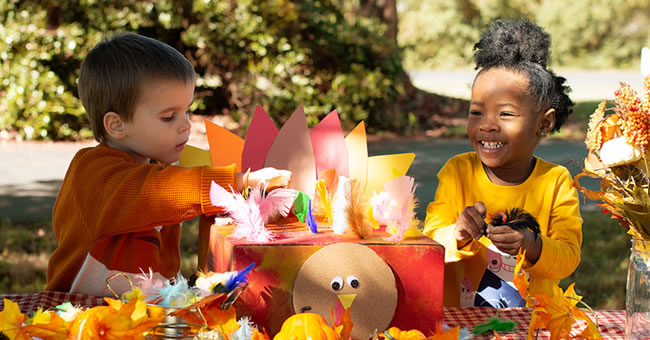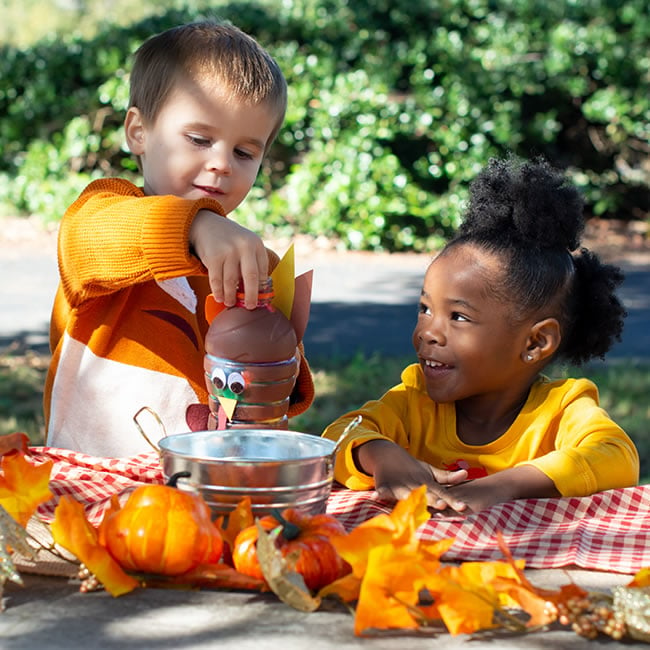
Want to do something more than the traditional hand turkeys to celebrate Thanksgiving in your classroom? We've got three turkey-themed fine motor activities for you and your students to gobble up! All three festive activities have a craft and activity element and are perfect for serving up holiday fun that is also educational.
What are the 3 Festive Fine Motor Activities for Thanksgiving?
The Hungry Turkey Challenge upcycles an empty plastic bottle and turns it into a turkey. With just paint, wiggly eyes, and construction paper, you can create a game that asks children to use their fine motor skills to pick up pompoms with tweezers or their fingers and put them in the decorated bottle to "feed" the turkey.
Children can further practice their fine motor skills with the Trace and Lace Turkey. Simply cut out a turkey shape from the flap of a cardboard box, decorate it, and add holes around the edge for children to lace.
The Turkey Feathers Game is the third activity and requires a few simple supplies, such as a cardboard box, paint, glue, and construction paper. It challenges children to use their fine motor skills to pick up feathers and place them in the appropriate holes on top of the decorated turkey box.

Why is it important to help children develop their fine motor skills?
Improving children's dexterity will help them be able to write, pick up items, hold books, and much more. Finding fun ways for children to develop their fine motor skills is an important part of your job as a caretaker or early childhood teacher. Activities such as the ones included in this article are great ways to bring fine motor practice into the classroom without letting children know that's what they're working on as they play and create.
Download our FREE printable below!

Required Materials:
- Construction Paper
- Scissors
- Wiggly Eyes
- Glue
- Empty Plastic Bottle
- Cardboard Box
- Acrylic Paint (red, orange, yellow, and brown)
- Paint Sponge
- Pompoms
- Easy-Grip Tweezers or Squeezy Tweezers™
- Box Cutter (adults only)
- Marker
- Tape
- Laces
- Hole Punch
- 6" Cork Circles
- Pencil
- Feathers
1Hungry Turkey Challenge
Cut out four feathers, a nose, and a wattle from fall-colored construction paper. Glue two wiggly eyes, the nose, and the wattle on the front of a recycled plastic bottle. Glue the turkey feathers together, and then glue the group of feathers onto the back of the bottle to make the turkey. Take a paint sponge and dab brown acrylic paint around the outside of the bottle. Let dry. Set out a variety of pompoms, and give children pairs of tweezers to use to pick up the pompoms and "feed" the hungry turkey. If children have a hard time with the tweezers, encourage them to use their hands to pick up the pompoms and put them in the turkey bottle.
2Trace and Lace Turkey
Use a box cutter to cut off the two shorter flaps of a cardboard box. Use a marker to draw or trace a turkey shape onto both flaps of cardboard. Cut out the two cardboard turkeys, and then glue wiggly eyes, a paper nose, and a paper wattle on the front of the turkey. Once that's done, use a hole punch to go around the edges of the cardboard turkeys and make holes for children to lace. Tape one end of a lace to the back of the turkeys, and then encourage children to practice their lacing skills.
3Turkey Feathers Game
Tape the top of the cardboard box you used for the Trace and Lace Turkey activity together, and then turn it over to where the bottom of the box is now the top. Next, glue wiggly eyes, a paper nose, and a paper wattle onto a Cork Circle and glue the circle onto the front side of the box (should be one of the shorter sides). Use a pencil to punch numerous holes in the top of the box. Cut out seven large feathers from fall-colored construction paper, glue the feathers together, and then glue the group of feathers on the back of the turkey box (the other short side of the box). Take a paint sponge and blend red, yellow, orange, and brown acrylic paint all around the cardboard box. Let dry. Give children feathers to stick into the holes to fill in the turkey's feathers.
Add these three festive and fun activities to your lesson plans for Thanksgiving. Be sure to browse our selection of manipulatives and related resources to help children work on developing their fine motor skills.
